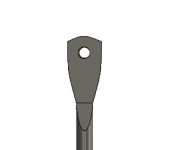I want to have two copies of a part I modeled in Fusion 360. It's Aluminum 6061 or 7075 (whichever at this point).
It's a 7 mm diameter rod bent or milled or whatever 10-13 degrees at the ends and then milled flat at the ends with a tapped hole on each end. The overall length would be 340 mm.
I'm not quite ready for them to be made yet only because I'm not certain just yet on the overall length or diameter; I may want to change the length up to 20 mm and I may want to change the rod diameter up to 1 mm wider for the final model. In any case, I wanted to see what the machinist or manufacturer would want from me or if the f3d file is sufficient.
This would be my first time having something made.
It's a 7 mm diameter rod bent or milled or whatever 10-13 degrees at the ends and then milled flat at the ends with a tapped hole on each end. The overall length would be 340 mm.
I'm not quite ready for them to be made yet only because I'm not certain just yet on the overall length or diameter; I may want to change the length up to 20 mm and I may want to change the rod diameter up to 1 mm wider for the final model. In any case, I wanted to see what the machinist or manufacturer would want from me or if the f3d file is sufficient.
This would be my first time having something made.







